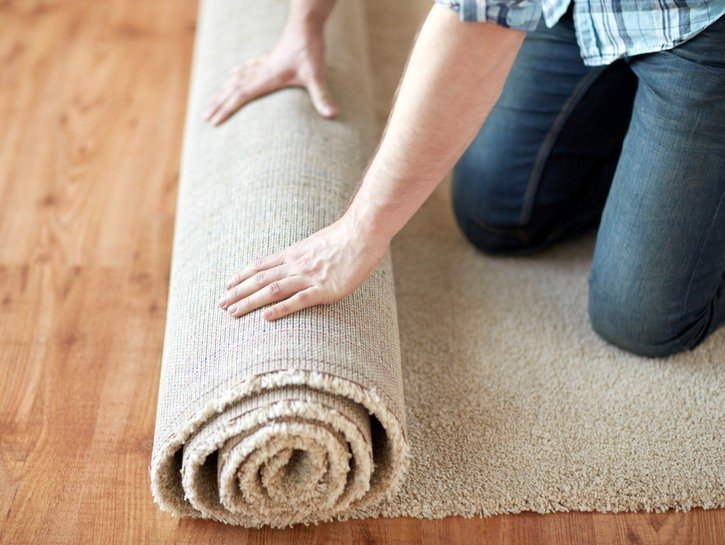Nothing ties a room together quite like a well-sized, appropriately-patterned area rug. And if you feel like your bedroom’s been looking a little bland lately, or your floor’s been a little colder than what’s comfortable, it may be time to try out a nice, new rug.
Rugs actually have a few benefits besides keeping your feet warm and acting as a more cushiony alternative to a hardwood floor. Most people don’t know that rugs absorb sound and can help keep rooms insulated by trapping cold air under the rug’s surface, helping the room maintain a warmer temperature overall.
But it can be tough knowing where to start once you’ve decided you’re going to take the plunge and go rug shopping. So we’ve broken it down and hopefully made it a little easier to get a better idea of what you’re looking for.

Iakov Filimonov/Shutterstock
Location, Location, Location!
The first question you’ll want to ask yourself is where you can see yourself placing the rug in the room. Is it going to be beside the bed so that it’s the first thing you step onto as you hop out of bed? Do you spend a lot of time sitting at a desk or at a makeup table where you could use a rug to make the space cozy? Or were you thinking of positioning your rug more centrally and making it an accent piece for decoration? Is there a particular section of the room you want to appear more inviting to visitors?

Digital Genetics/Shutterstock
Basic Rug Sizing Guidelines
- No matter the room, an area rug should never touch the walls. Leave at least five inches between the edge of the rug and the walls, or if the room is especially large, a minimum of eight inches will be ideal.
- An area rug shouldn’t touch the edges of any furniture, with the exception being if the rug is big enough to be slipped under a piece of furniture. For smaller rugs, leave at least two or three inches of floor space between furniture and the rug’s edges.
- A tiny room doesn’t necessarily call for a tiny rug! In fact, it can be really aesthetically effective to keep the eyes busy with a patterned rug that covers most of the floor space.
- If the bedroom door or closet will be swinging over the space covered by the rug, make sure to keep the thickness of the rug in mind when shopping, so you can be sure the door will clear the rug every time it opens.

severija/Shutterstock
Rug Sizes And Beds
If you’d like a giant rug underneath the bed so that its area extends out from all of the bed’s open sides, you have two options. You can either position the rug so that all of the bed and the bedside table(s) are resting on it symmetrically, or you can set up the rug so that only the lower two-thirds of the bed cover the area of the rug. With the first option you get a more symmetrical look, but the second option gives your floor coverage where it’s needed – where you’ll actually be stepping when you climb in and out of bed. Regardless of which look you go with, the rug should extend at least twelve inches from the bottom and sides of the bed if it’s a twin, and eighteen inches if you have a queen or king size bed.
Approximately, you’ll want:
- 8×10 rug for a queen or king sized bed, including nightstands
- 6×9 rug for a queen or king sized bed, not including nightstands
- 6×9 rug for a twin bed, including one nightstand
- 5×8 rug for a twin bed, not including nightstand

severija/Shutterstock
Guidelines For Bedside Rugs
For rugs you want to run along the sides of your bed, your rug dimensions will depend a little on the size of your room. If you want more coverage by your bed, go for a runner rug that’s the same length as your mattress. For smaller rooms, a 2×3 will be fine, whereas a larger room could accommodate a 3×5 nicely.
If you like the idea of a rug at the foot of the bed, you can always pair it with one of the ones you’ve set up along the sides. If you have a bench at the end of your bed, you’ll want a rug that fits underneath the bench and extends to the end of the mattress. For most bedrooms, a 4×6 rug will work.

Interior Design/Shutterstock
Other Rug Uses In Bedrooms
If you’d like to define a space within the bedroom, a distinct rug is a good option! Whether it’s a workspace, sitting area, or reading corner, a rug can be a cozy addition to the space and can do wonders to set that area apart from the rest of the room. A rug that covers most of the floors space is a good idea, but remember to make sure it doesn’t run up against the walls. If you choose to run the rug under the furniture of that area, make sure the rug touches that furniture only as opposed to other furniture pieces in the room.
Keep in mind that these are only guidelines and decorating is about finding what you like and what works for you. So don’t be afraid to try something new and different!
